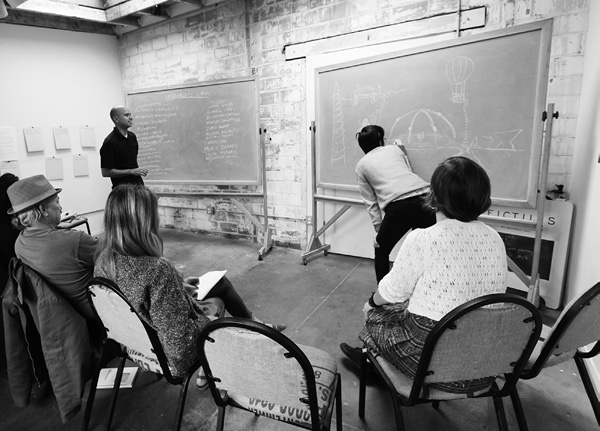
VAGUE NOTIONS
first performed on July 16, 2014
Interface Gallery, Oakland, CA
performed seventeen times in 2014
FICTILIS
Oakland, CA
746401275i746401275n746401275f746401275o746401275@746401275f746401275i746401275c746401275t746401275i746401275l746401275i746401275s746401275.746401275c746401275o746401275m
fictilis.com
VAGUE NOTIONS
FICTILIS
From July 16th to August 10th 2014, FICTILIS performed “Vague Notions,” a series of low-pressure, open-ended “brainstorming sessions,” at Interface Gallery in Oakland, California. Each session was free and open to the public. “Topics” for the sessions were submitted by gallery visitors and artists from Oakland and beyond, and ranged from broad themes or subjects to specific issues, questions, problems or single-word prompts—anything that could feasibly be discussed for approximately one hour in a small group setting.
Topics included: What to Brainstorm; Art and the Mundane (from Felicity Fenton); anticipatory haiku (from Missa Coffman); the problem of the ORIGINAL in new media arts (from Omer Golan, facilitated by Jennifer Parker); Vague Notations, or Please Befigulate: The League of Imaginary Scientists in conversation with FICTILIS and friends; Vagina-Centered Artworks: a discussion (from Allison Kotzig, facilitated by Sabrina Habel); Imagined Cities (with Justin Mata); entertainment for disability in public places (with Sanaz Sarabi); Prolepsis and Creativity (with Alan Hopkins); earliest childhood dream or memory (with Den Zolo); childhood language games; Prowling The Deep; and What’s the Point?
Some sessions were scheduled, some were impromptu. Some were facilitated by the submitters of the session topic while others were led by special guest facilitators. All sessions were conducted using large rolling chalkboards, with FICTILIS and other participants assisting with transcription. After each session, these chalkboards were systematically photographed, then left in the space un-erased until the next scheduled brainstorm, to be experienced as artifacts containing the traces of conversations which took place there. Visitors to the gallery could add to the boards or erase them and perform their own brainstorming sessions.
The purpose of this performance series was to force ourselves into some uncomfortable situations, to see how a diverse set of prompts could be translated into spoken and written form by a small group of participants, and to attempt to fashion a performance out of the very process of coming up with an idea for a performance in the first place. The project was a response to increasing consideration of ethics in socially engaged art and the already-widespread privileging of “ideation” and other “creative” practices in Bay Area tech culture.